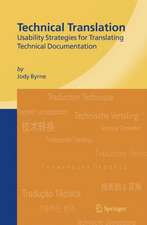The Language of Money and Debt: A Multidisciplinary Approach
Editat de Annabelle Mooney, Evi Sifakien Limba Engleză Hardback – 26 iul 2017
This book analyses the language that ordinary people employ when discussing money, debt and financial behaviour. It documents and critiques this language from an array of disciplinary perspectives, with chapters on children’s books, government infomercials, television poverty porn, the emotional experience of being indebted, and more. In doing so, it addresses common underlying questions concerning definitions of money and value, and scrutinises how people construct, negotiate and articulate meaning in these domains. This wide-ranging edited collection will be of interest to students and scholars of linguistics, sociology, communication, literature and anthropology.
| Toate formatele și edițiile | Preț | Express |
|---|---|---|
| Paperback (1) | 639.73 lei 6-8 săpt. | |
| Springer International Publishing – 12 aug 2018 | 639.73 lei 6-8 săpt. | |
| Hardback (1) | 650.19 lei 6-8 săpt. | |
| Springer International Publishing – 26 iul 2017 | 650.19 lei 6-8 săpt. |
Preț: 650.19 lei
Preț vechi: 764.93 lei
-15% Nou
Puncte Express: 975
Preț estimativ în valută:
124.43€ • 135.11$ • 104.52£
124.43€ • 135.11$ • 104.52£
Carte tipărită la comandă
Livrare economică 23 aprilie-07 mai
Preluare comenzi: 021 569.72.76
Specificații
ISBN-13: 9783319575674
ISBN-10: 3319575678
Pagini: 329
Ilustrații: XV, 316 p. 9 illus., 2 illus. in color.
Dimensiuni: 148 x 210 x 24 mm
Greutate: 0.69 kg
Ediția:1st ed. 2017
Editura: Springer International Publishing
Colecția Palgrave Macmillan
Locul publicării:Cham, Switzerland
ISBN-10: 3319575678
Pagini: 329
Ilustrații: XV, 316 p. 9 illus., 2 illus. in color.
Dimensiuni: 148 x 210 x 24 mm
Greutate: 0.69 kg
Ediția:1st ed. 2017
Editura: Springer International Publishing
Colecția Palgrave Macmillan
Locul publicării:Cham, Switzerland
Cuprins
Chapter 1:- Introduction: The View from the ground; Annabelle Mooney and Evi Sifaki.- I. Money and Childhood.- Chapter 2: Stories of value: The nature of money in three classic British picture books; Astrid Van den Bossche.- Chapter 3: The treatment of money and wealth in the Harry Potter series; Tanweer Ali and Eva Lebdušková.- II. Money and the Everyday.- Chapter 4: Money Talk at the Mass Observation Archive; Liz Moor.- Chapter 5: Snudging Cheapskates and Magnificent Profusion: The Conceptual Baggage of 'mean' and 'generous.'; Annabelle Mooney and Evi Sifaki.- Chapter 6: Neoliberalism in the academy: Have you drunk the Kool-Aid?; Liz Morrish.- Chapter 7: Falling Behind: Debtors' Emotional Relationships to Creditors; Anna Custers.- III. Money and the Media.- Chapter 8: The language of "Welfare Dependency" and "Benefit Cheats": Internalising and reproducing the hegemonic and discursive rhetoric of "benefit scroungers"; Chris Roberts.- Chapter 9: Does money talk equate to class talk?Audience responses to poverty porn in relation to money and debt; Laura L. Paterson, David Peplow and Karen Grainger.- Chapter 10: The Discourse of alternative credit: a multimodal critical examination of the Cash Converters mobile app; Gavin Brookes and Kevin Harvey.- IV. What is Money?.- Chapter 11: The Sociality of Debt: A Case Study of Kamba (Kenya) Conceptualisations of Borrowing and Lending; Froukje Krijtenburg.- Chapter 12: What is Money? Legal Language as Modern Day Alchemy; Kate Harrington.
Notă biografică
Annabelle Mooney is Professor of Language and Society at the University of Roehampton, UK. Her research interests include the language of money and financial literacy, and the language of human rights.
Evi Sifaki is Senior Lecturer in Linguistics at the University of Roehampton, UK. Her main research focus is the syntax of different word order phenomena, and the documentation of various aspects of morphosyntactic change.
Textul de pe ultima copertă
This book analyses the language that ordinary people employ when discussing money, debt and financial behaviour. It documents and critiques this language from an array of disciplinary perspectives, with chapters on children’s books, government infomercials, television poverty porn, the emotional experience of being indebted, and more. In doing so, it addresses common underlying questions concerning definitions of money and value, and scrutinises how people construct, negotiate and articulate meaning in these domains. This wide-ranging edited collection will be of interest to students and scholars of linguistics, sociology, communication, literature and anthropology.
Caracteristici
Compares the models with which lay individuals work with ‘official’ models of money and the economy Provides an important perspective on lay discourses and behaviours with money, something of great value to those who would encourage ‘good’ financial behaviour and economic literacy Makes clear that while money may be conceptualised as a thing it is rather an index of a range of other emotions, beliefs, relationships and social structures















